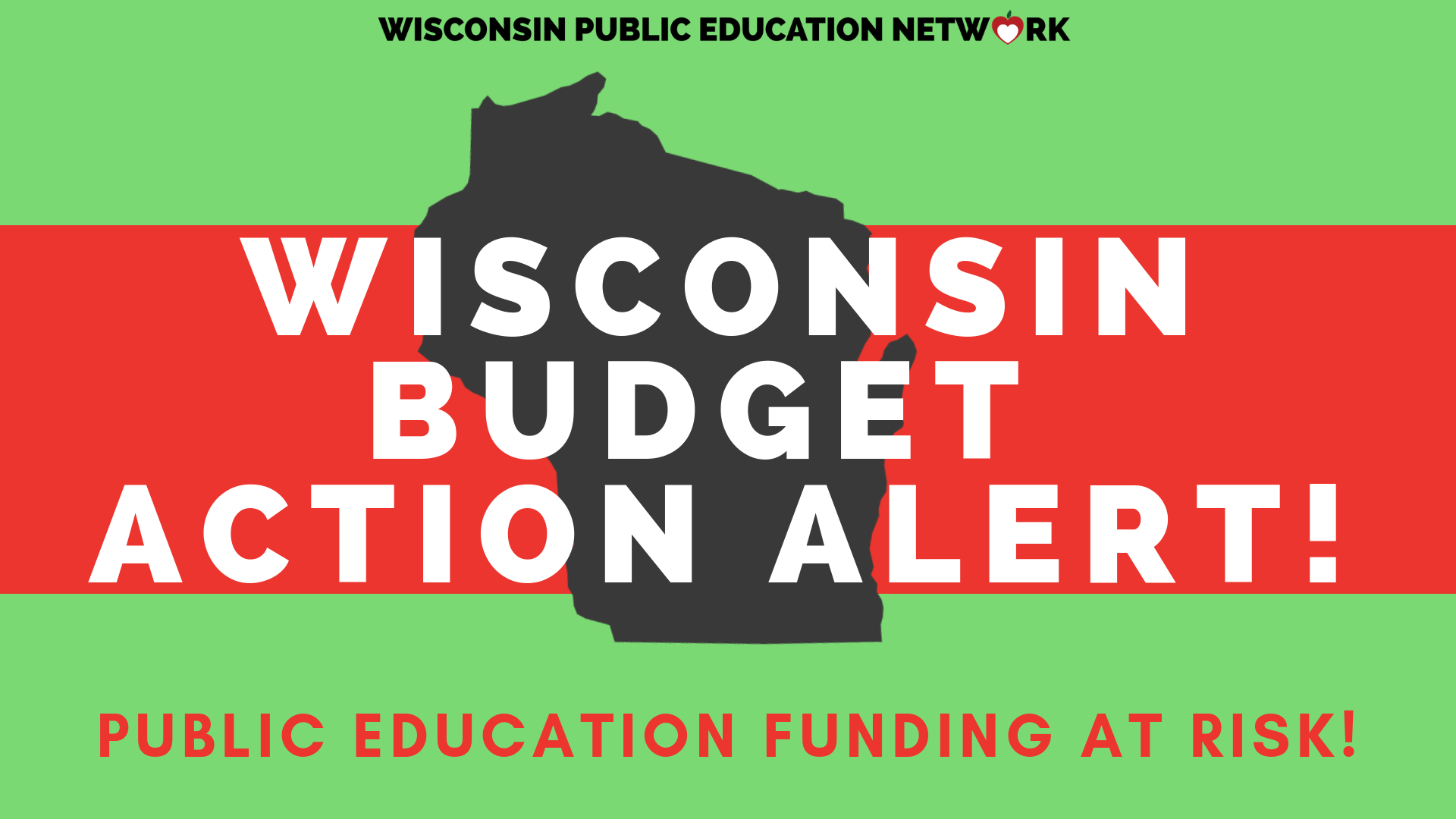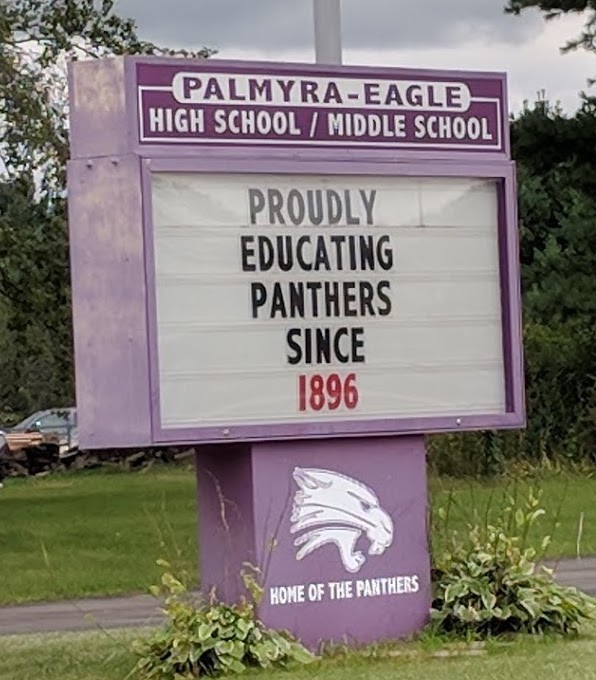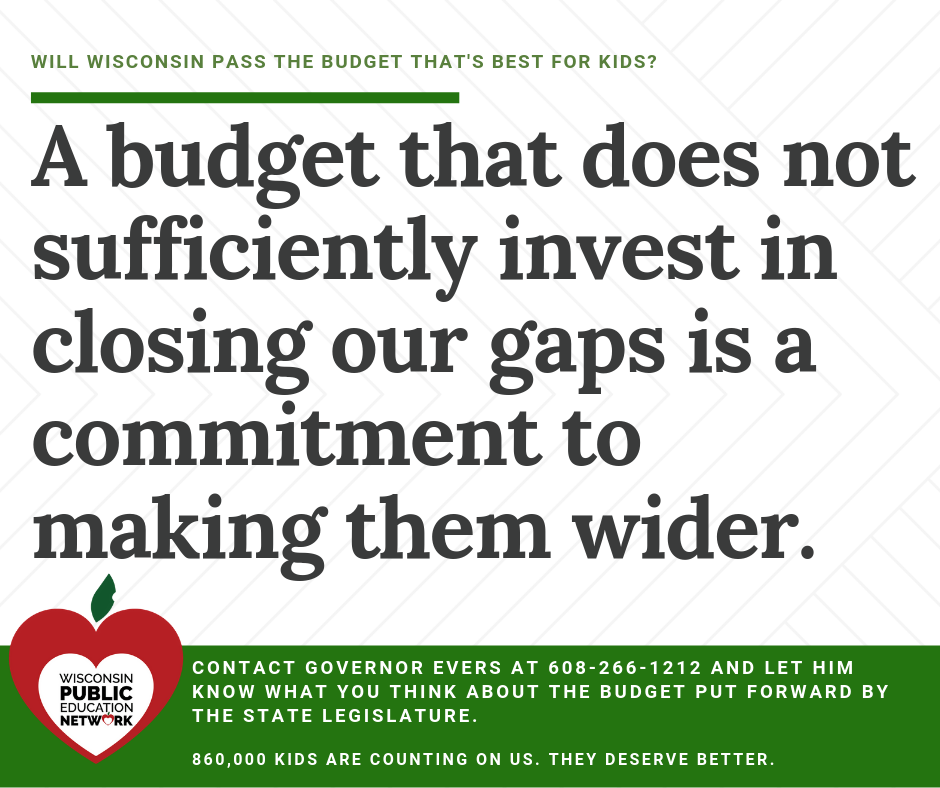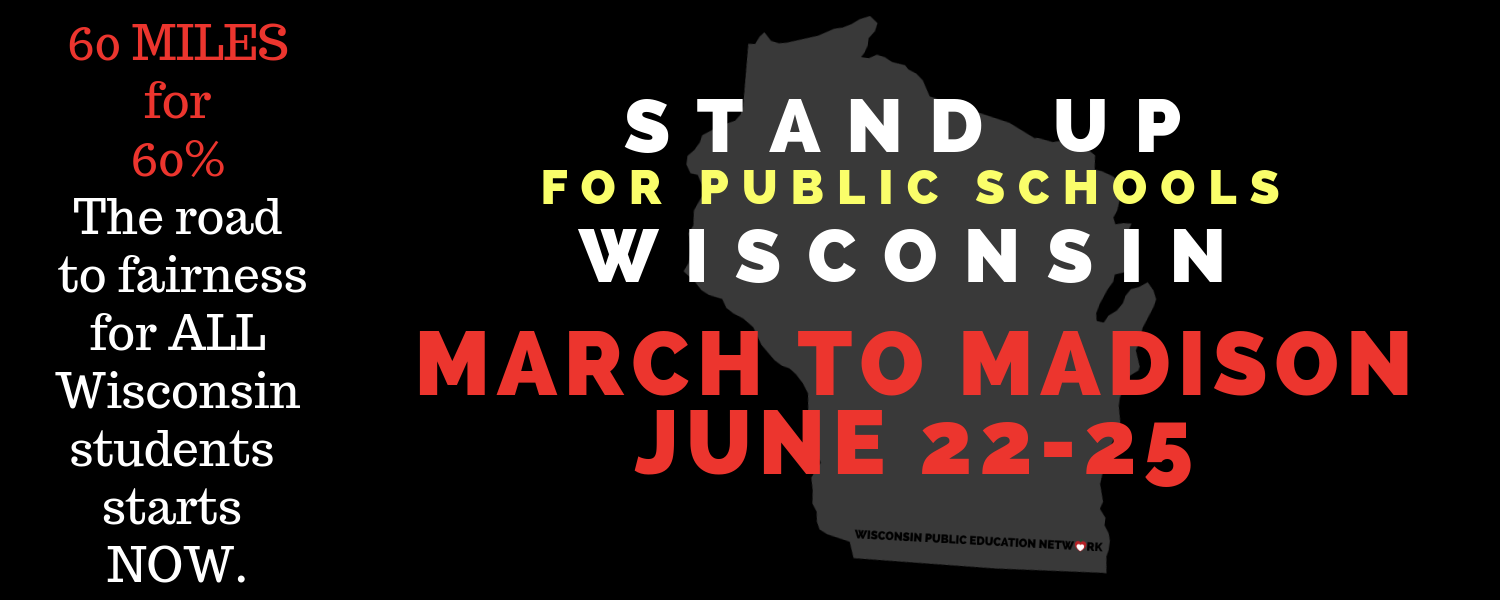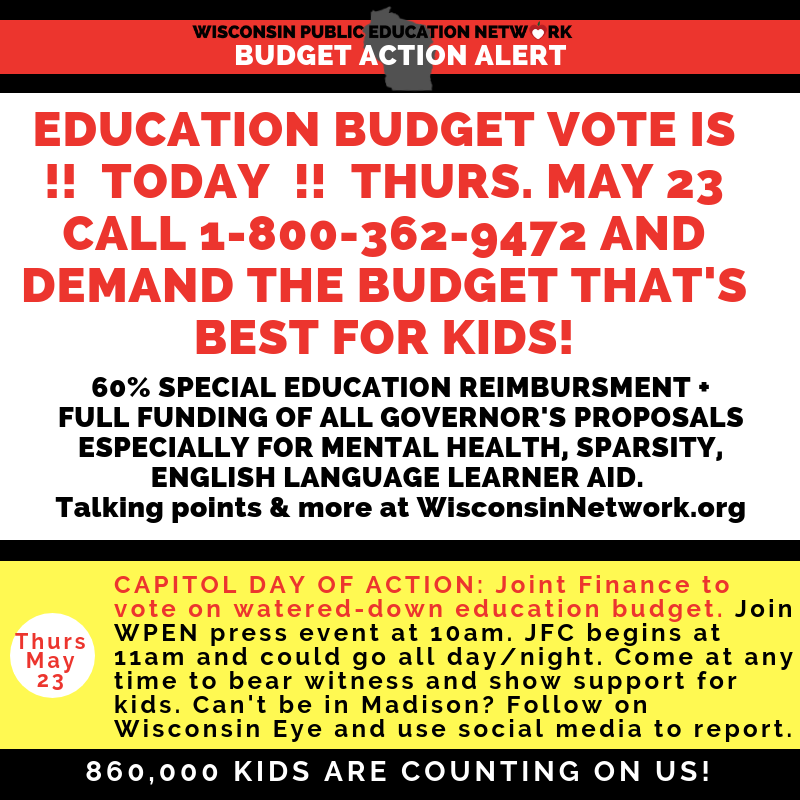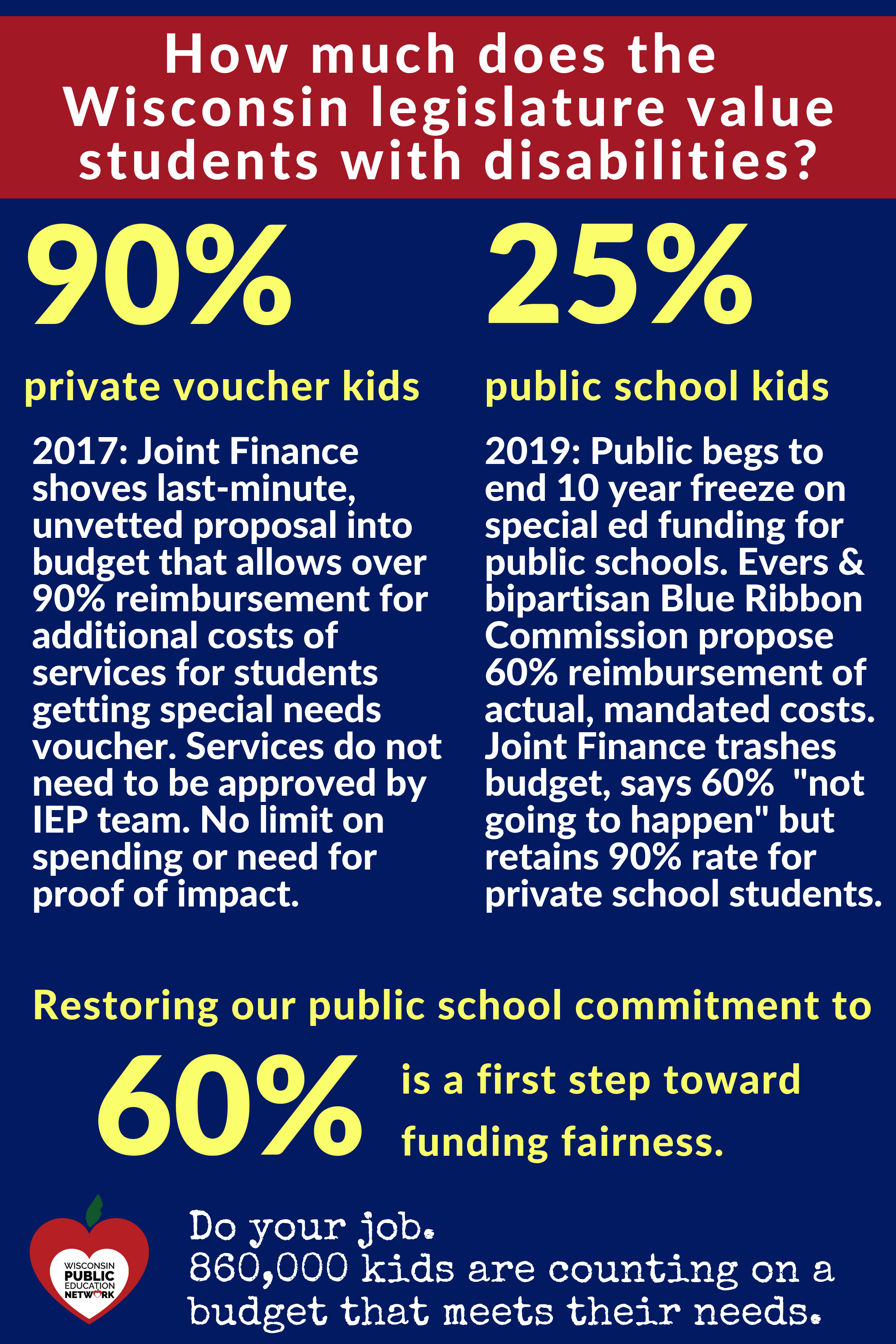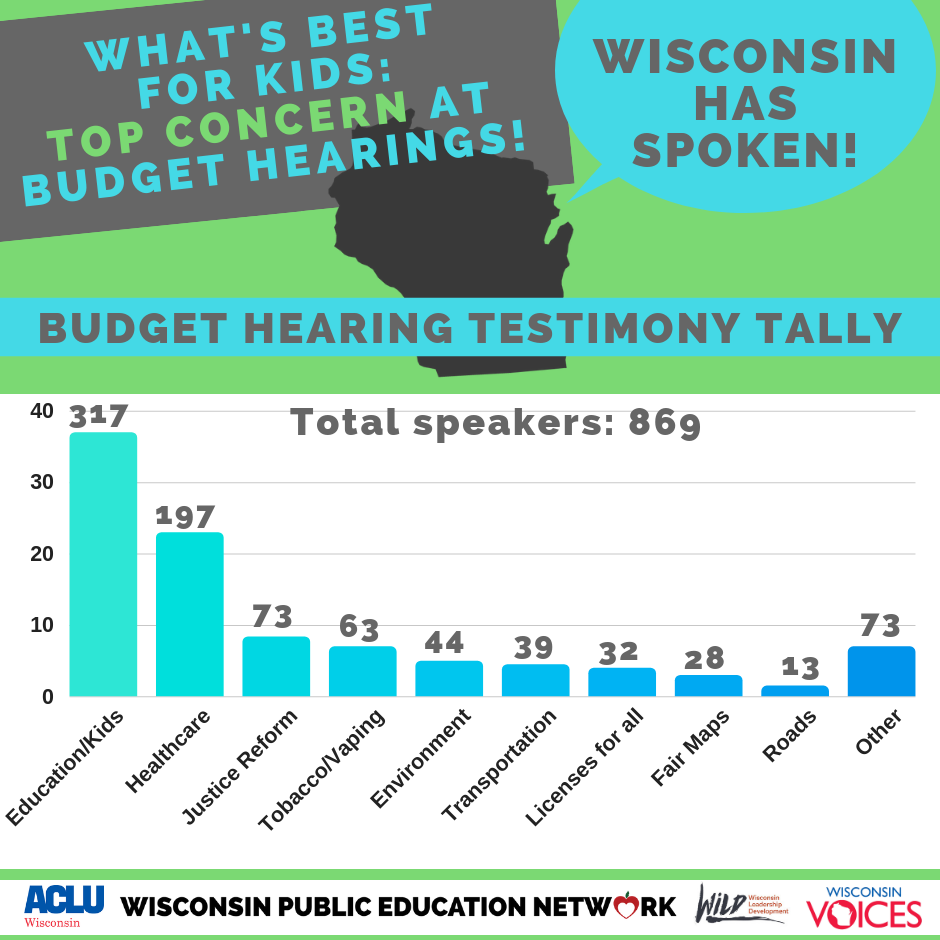PUBLIC EDUCATION FUNDING IS AT RISK and the time to speak up on the budget is NOW.

Thank you for taking time to contact your elected officials! See below for a copy/pastable list of Joint Finance Committee members’ emails.
We’ve been getting a lot of questions about what the removal of a long list of items from the Governor’s proposed budget means to kids, and what people can do about it. We’ve provided a detailed explanation of what we learned about the state budget process this week below, but the actual message is simple: the people have spoken, and lawmakers know what our kids need most to succeed. And they are telling us: we’re not going to provide it.
Republican leaders of Joint Finance announced in a memo this week that they intend to strip numerous policy measures from the Governor’s proposed budget, including the expansion of Medicaid which would have generated additional funding to support school measures. The lengthy list (below) notably includes both fiscal and non-fiscal items, including deletion of the Governor’s proposals to cap voucher enrollment and to repeal a provision tacked onto the previous budget in a last-minute Omnibus motion that provides a 90% reimbursement rate for special education costs for students receiving Special Needs Scholarship vouchers. This is unacceptable.
Here’s what you need to know:
- Districts statewide have demanded a 90% special education reimbursement from the state to help fill the $2 billion special education funding gap our schools face in the biennium. That’s $1 BILLION A YEAR that districts are transferring from their general fund (Fund 10) to their special education funds (Fund 27) to cover actual, unreimbursed, mandated special education costs. National experts have pointed out that our current reimbursement rate (25%) is the lowest in the nation. This is unacceptable.
- The plan from Governor Evers would increase the reimbursement rate to 30% in year one and 60% in year two, setting the course to a 90% reimbursement. You can see what 60% would mean to your district here, but the simple fact is that a 60% reimbursement doesn’t even cover half of the funding gap for most districts. It’s not “too much” as some legislators have suggested – it’s not nearly enough. And yet…we are hearing talk of increasing the reimbursement to just 30%. This is unacceptable.
- The special education reimbursement plan is the single most transformative element of the Governor’s budget proposal. Without it, we simply double down on the status quo of failing to support our most vulnerable students. Any budget that does not invest in closing these funding gaps is an explicit investment in widening them. This is unacceptable.
- Many legislators are paying lip service to meeting a 2/3 state funding commitment. We ask: 2/3 of what? Unless that 2/3 funding comes with a matching increase to both spending and revenue limit authority, not a single new dollar gets into our classrooms. That’s not aid. It’s just property tax relief. This is unacceptable.
- If the legislature passes a budget that does NOT include the Governor’s special education proposal, but simply provides a per-pupil increase of $200 per student in year one and $204 in year two, Wisconsin’s children are looking at a cut of about $12 million compared to the previous budget, when adjusted for inflation. It’s not even an inflationary increase. It’s an insulting amount that doesn’t restore a penny of desperately needed funds that have been cut and pilfered by previous budgets. Wisconsin has told lawmakers what our kids need to swim, and the proposed cuts would leave them underwater. This is unacceptable.
- There are many proposals still on the table that would help kids and schools. These proposals have been vetted by the Governor, the bipartisan Blue Ribbon Commission on School funding, and supported resoundingly by parents, educators, and school leaders around the state (WASB has put together this helpful list here). We need to fight for all of them. The plan that’s best for kids is in serious jeopardy right now. This is unacceptable.
The plan that’s on the table has been vetted and approved by the Governor, the bipartisan Blue Ribbon Commission on School funding, and the people of Wisconsin. It’s the plan that’s best for kids.
The plan that’s best for kids is the only plan worth accepting.
Accept nothing less.
860,000 kids are counting on us.
EDUCATION-RELATED ITEMS THAT WILL BE INCLUDED IN THE MOTION TO EXCLUDE FROM CONSIDERATION IN THE BUDGET:
Page numbers correspond to the LFB budget summary here.
General School Aids and Revenue Limits
- Reallocate Property Tax Credit Funding to General School Aids Appropriation (Page 317, #5 and Page 385, #1)
- Revenue Limit Adjustment for Lead Testing and Remediation (Page 321, #14)
- Four-Year-Old Kindergarten Membership (Page 322, #15)
- Limit on Number of School District Referenda (Page 322, #16)
Categorical Aids
- Driver Education Aid (Page 333, #29)
Choice, Charter, SNSP, and Open Enrollment
- Private School Choice Programs — Cap Participation at 2020-21 Levels (Page 339, #3)
- Private School Choice Programs — Teacher Licensure Requirement (Page 340, #4)
- Private School Choice Programs — Accreditation of Private Schools (Page 341, #5)
- Milwaukee Private School Choice Program — Eliminate City Choice Levy Aid (Page 342, #6)
- Private School Choice Programs — Definition of Poverty Level (Page 342, #7)
- Private School Choice and Special Needs Scholarship Programs — Information Required on Property Tax Bill (Page 342, #8 and Page 390, #6)
- Special Needs Scholarship Program — Sunset (Page 344, #10)
- Special Needs Scholarship Program — Teacher Licensure Requirement (Page 344, #11)
- Special Needs Scholarship Program — Private School Requirements (Page 344, #12)
- Special Needs Scholarship Program — Delete Cost Reimbursement Provision (Page 346, #13)
- Special Education Scholarship Program — Additional Tuition Charges (Page 347, #14)
- Special Education Scholarship Program — Religious Activity Opt-Out (Page 348, #15)
- Prohibition on New Independent Charter Schools (Page 349, #17)
- Opportunity Schools and Partnership Program (Page 351, #20)
Administrative and Other Funding
- Eliminate Teacher Licensure for Alternative Teaching Preparation Program (Page 354, #5)
- Paid Planning Time for Teachers (Page 359, #23)
Related Items in other Agencies
- Rehired Annuitant Teachers (Page 119, #3) [ETF]
- Student Loan Refinancing Study Committee (Page 130, #2; Page 229, #10; and Page 396, #2) [HEAB]
- Transfer Office of School Safety (Page 252, #6 and Page 358, #22) [DOJ]
- Agency Publications (Page 262, #8) [LEGISLATURE] [Act 369]
- Administrative Rules (Page 262, #9) [LEGISLATURE] [Act 369]
- Municipal Broadband Facilities in Underserved or Unserved Areas (Page 361, #3) [PSCD]
- Transfers from DWD to DPI [DWD]
- Career and Technical Education Grants and Completion Awards (Page 330, #21 and Page 463, #1)
- Technical Education Equipment Grant Program (Page 331, #22 and Page 464, #3)
- Teacher Development Grants (Page 335, #33; Page 464, #4; and Page 464, #5)

Individual email addresses for Joint Finance Committee members:
What’s Best for Kids & Schools was the primary concern at the four hearings on the state budget held in April. See our full report here.


